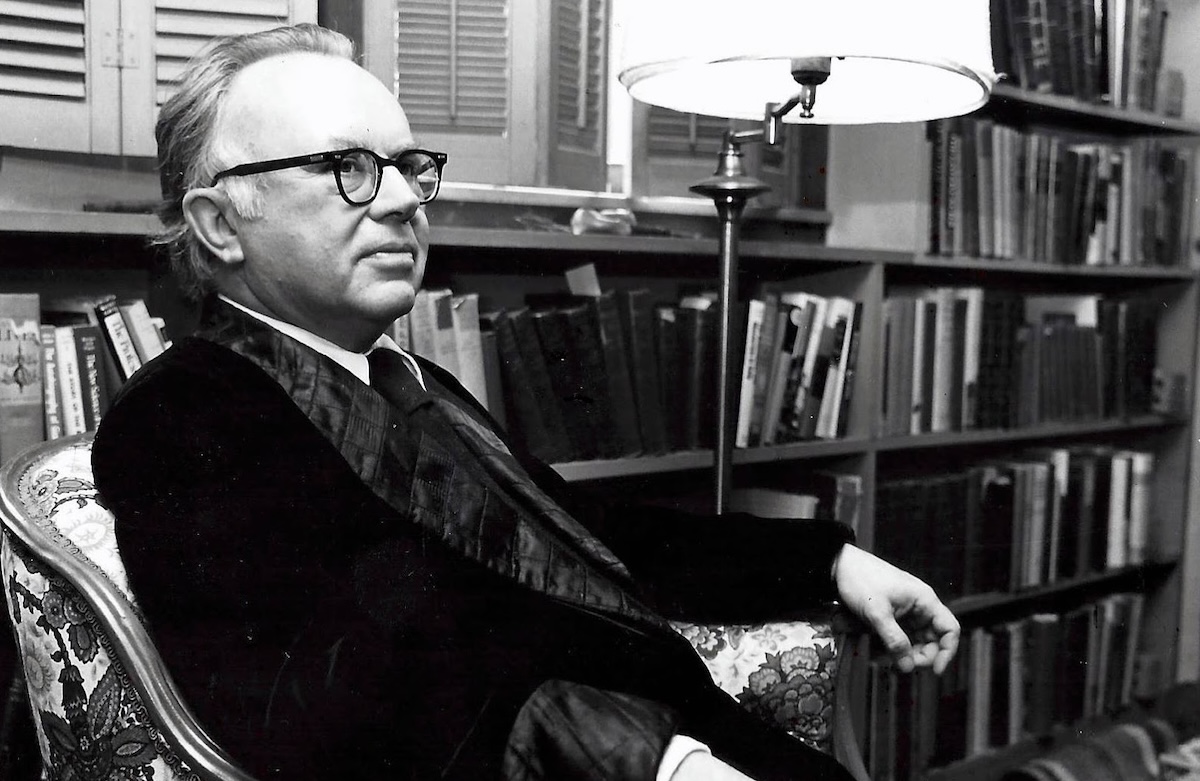The publication of Camilo Peralta’s The Wizard of Mecosta: Russell Kirk, Gothic Fiction, and the Moral Imagination by Vernon Press is an exciting development. Peralta is part of a rising generation of scholars and completed his doctoral work at Faulkner University and spent time at Piety Hill as both a Russell Kirk seminar attendee and a research fellow in the Kirk Center’s Wilbur Fellow program. Kirk’s position in mid-20th-century intellectual conservatism has proved a crucial part of building the modern conservative movement, and additional scholarship on Kirk contributes to the prestige of the Sage of Piety Hill. At $78 for the hardback and $100 for the ebook, The Wizard of Mecosta, however, is priced for academic libraries and will be of interest to academics with a research interest in Russell Kirk, 20th-century Gothic literature, and T.S. Eliot.
Russell Kirk is a fascinating writer to evaluate. He was at his most persuasive when writing to an educated generalist audience, as he does in Enemies of the Permanent Things and Roots of American Order. His dissertation, published as The Conservative Mind, communicated the nuances of the conservative disposition to mainstream America. It’s difficult to imagine a volume dedicated to describing the six (later expanded to 10) canons of conservatism, written in a style filled with allusions to hundreds of other books, becoming a runaway bestseller. But such was the case for The Conservative Mind in the 1950s. It remains in print, and for more than 80 years has inspired rising generations of conservatives to dig deep into the tradition of thought first articulated by Edmund Burke.
While Kirk’s nonfiction has been thoroughly explored, as has his life (most recently by Dr. Brad Birzer in Russell Amos Kirk: American Conservative), Peralta is interested in Kirk’s fiction. Kirk published three volumes of short stories and three novels. Peralta argues that it is in his fiction that Kirk best articulates his “keen sense of the moral imagination, which Kirk equates with the normative and prescriptive end of humane letters” and that “surely, it is in his fictional worlds, and especially in the male and female characters who populate them, that Kirk was best able to live up to the calling of the formidable John of Brienne.” Kirk’s fiction writings, Peralta insists, have not been adequately studied, and Peralta’s book is a first step in remedying that gap in Kirk scholarship.
Peralta dedicates a chapter to describing Kirk’s literary style, chapters to Gothic literature as a genre and to Kirk’s theory of “timeless moments,” a chapter to each of Kirk’s novels, and a closing chapter on Manfred Arcane (whom Peralta judges to be Kirk’s most successful character). In poring over The Wizard of Mecosta, the reader will grasp a sense of Kirk’s plots, efforts toward characterization, and place in the development of Gothic literature. Peralta’s best analysis lies in his description of Kirk’s style. Peralta writes that readers
will learn, for instance, that [Kirk] is fond of repetition, often employing the same words and phrases from his favorite authors, such as Edmund Burke or T.S. Eliot, in multiple texts. He frequently begins sentences with the words “Why” or “Aye” and favors elaborate, even Latinate, sentence structures. But perhaps the most characteristic feature of Kirk’s style, which is so prevalent in his fiction, is the high number of allusions packed into each page.
Peralta provides charts detailing Kirk’s allusions to the Bible and Shakespeare in his novels and argues that they serve a specific purpose: “A carefully chosen allusion, in other words, will do much more than simply make the author look smart or well-read: it serves a dialogic purpose, bringing the author and his readers into conversation with the older text.” Advancing this dialogue between his readers and the older texts of the Western tradition, Peralta contends, was one of Kirk’s primary goals. One of the ways Kirk sought to advance the moral imagination of his readers was by connecting them to other authors. His stories became places where readers encounter permanent truths: “the permanent things might be described as the end or aim of the moral imagination: the latter is intended to guide the reader into the former.”
Kirk’s fiction, then, sought to convey a greater awareness of reality: the impossibility of government planning accomplishing its ends, the importance of virtue, and the spiritual domain of life as both real and higher than the material plane. For these aims, Kirk found Gothic fiction, with its haunted castles, scenes bordering the spirit realm, and ghostly appearances, a natural fit. His friendship with T.S. Eliot resulted in his final novel, Lord of Hollow Dark, featuring characters with nicknames culled from Eliot’s poetry. The better read in Eliot the reader is, the more significant these allusions become.
The strengths of The Wizard of Mecosta lie in Peralta’s love for Kirk’s stories. In several places, he suggests that Kirk’s novels merit far more study and acclaim than they initially received (or have received since publication). Although Peralta argues that Kirk’s moral imagination comes through most clearly in his fiction, I find the opposite to be true. In his criticism, in his essays, and in his longer nonfiction works, Kirk better communicates the truths of the Western tradition in persuasive prose. His Roots of American Order demonstrates strong scholarship and an impressive ability to synthesize and summarize while never forgetting his dominant historical argument. My students and I finished our time reading Roots with an increased appreciation for the ways in which the American experiment depended on immense intellectual resources inherited from Athens, Rome, Jerusalem, and London. I did not have that experience when reading Lord of the Hollow Dark. Peralta praises Kirk’s allusive ode to T.S. Eliot as a masterpiece of fiction, but the narrative is difficult to follow and the allusions impenetrable without recent advanced study of Eliot’s poetry. These barriers prevent the novel from communicating in clear images.
Kirk’s fiction is certainly worth reading, but it pales in comparison to his autobiography, The Sword of the Imagination, or his edited volume of occasional writings, Enemies of the Permanent Things. In Enemies, Kirk provides a clear vision of norms and articulates the sources from which we draw those norms that lead to civilizational flourishing. Beyond his writings, Kirk was a great man in his personal life; Peralta highlights the success of Kirk’s marriage, work as a father, and incredible hospitality. But not all his writings are created equal.
A second weakness of Wizard of Mecosta lies in Peralta’s focus on connecting Kirk’s characters to episodes in Kirk’s life. Rather than judging the characters as strong or weak within the context of the story or how lifelike they become, Peralta explores them through comparison to known events or relationships in Kirk’s life. Manfred Arcane and Melchiora are thus directly linked to Russell and Annette Kirk: Kirk’s “happiness with Annette is evident in the evolving relationship between Arcane and Melchiora over the years.” The connections between Kirk and Arcane are superficial, however—both use walking sticks and dress in old-fashioned attire. The same is true for Annette and Melchiora; Peralta draws the association because Annette had long black hair in her youth and a “haughty” spirit when she and Kirk first met. This relationship might exist, but it may also be purely accidental.
Peralta’s speculation goes even further: “Perhaps their generosity towards others helps to explain why Kirk always depicts Arcane as being surrounded by a crew of misfits: whether in Haggat or Scotland, he seems to attract to himself those with nowhere else to go and few viable skills to offer anyone, like the mutilated Arpad Nemo or failed architect, Sweeney.” But Kirk’s habit of extending charity to vagrants and Manfred Arcane’s gathering of otherwise purposeless figures is tenuous and adds nothing to the reader’s understanding of Arcane’s role in the story. Peralta would have been better off drawing from Tolkien’s “On Fairy Stories”: judge characters and plots on whether they have the “ring of primary reality” within the secondary reality of the narrative. Or, as Aristotle suggested, whether the story produces some cathartic moment of realization through mimetic reflection of reality. Sir Phillip Sidney argued that literature was superior to both philosophy and history because of its ability to create living images that resonate within the reader’s mind; such would have been a more compelling criterion for evaluating Kirk’s novels. Considering characters in relation to Kirk’s life does not advance or deepen the reader’s understanding of the stories themselves.
With that said, The Wizard of Mecosta succeeds in extending the reader’s understanding of Kirk’s fiction in light of Kirk’s goals: to remind the reader of the permanent things through engagement with the moral imagination. Peralta’s is a work of able Kirk scholarship, and authors seeking to better understand the fiction of the Sage of Mecosta will benefit from it. Just remember to revisit the nonfiction for a more robust picture of Kirk’s permanent contributions to “the conservative mind.”

